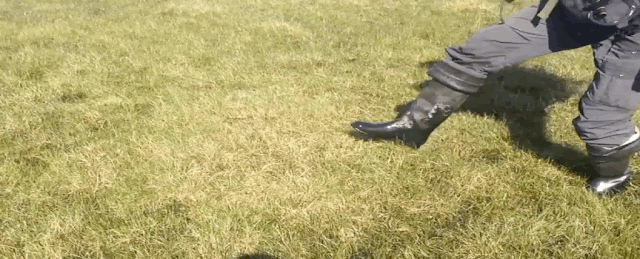7,000 large gas Bubbles Have formed under Siberia and could Explode at Any second
What happens when the permafrost thaws.
last yr, researchers in Siberia's faraway Bely Island made the weird discovery that the ground had started out effervescent in certain places, and was squishy beneath the locals' toes like jelly.
on the time, simply 15 of these swollen bubbles had been identified, but an investigation within the wider place of the Yamal and Gydan peninsulas has revealed that 7,000 or so of them have sprung up, and the concern now is that they might explode at any moment.
"At first, such a bump is a bubble or 'bulgunyakh' in the local Yakut language," Alexey Titovsky, director of the Yamal department for technology and Innovation, told The Siberia times.
"With time, the bubble explodes, releasing gas. This is how gigantic funnels form."
those massive funnels Titovsky is referring to are every bit as intimidating as they sound.
at the same time as collapsed bubbles can form pretty small 'pockmarks' inside the ground, they have got also been linked to the large sinkholes and craters which have been appearing across Siberia:
Now photograph lots of those death traps dotted across the landscape, with each of the 7,000 newly identified bubbles poised to blow up without caution.
So what exactly is going on right here?
again in 2016, local environmental researchers Alexander Sokolov and Dorothee Ehrich decided to tug back the dirt and grass that had been blanketing these bulging bumps of earth and observed that the air escaping from them contained up to 1,000 times more methane than the surrounding air, and 25 times extra carbon dioxide.
And matters can get even odder at the bottom of the most important sinkholes - a 2014 research into a 30-metre-wide (98-foot) crater on the Yamal Peninsula determined that air near the lowest of the crater contained unusually excessive concentrations of methane - as much as 9.6 percent.
As Katia Moskvitch mentioned for Nature at the time, archaeologist Andrei Plekhanov from the scientific Centre of Arctic studies in Salekhard, Russia, instructed her that the surrounding air usually includes just 0.000179 percentage methane.
Researchers have hypothesized that these methane bubbles are linked to a recent heatwave that had brought on the Siberian tundra's permafrost to thaw.
Siberia's permafrost has to turn out to be well-known for its capability to hold things flawlessly preserved for hundreds of years, including this top notch 12,400-year-old pup, or these lovely lion cubs, which nonetheless had their tawny fur coats on after 30,000 years.
A 2013 observe found that a international temperature upward thrust of 1.5°C would be sufficient to kickstart an extraordinary duration of melting, however thanks to abnormally warm summers related to weather change, nearby researchers suspect that that is already beginning to arise, with each day temperatures in July 2016 hitting a disturbing 35°C (95°F).
"Their appearance at such high latitudes is most likely linked to thawing permafrost, which in is in turn linked to overall rise of temperature on the north of Eurasia during last several decades" a spokesperson for the Ural branch of Russian Academy of science told The Siberian times.
we're nonetheless waiting on a few peer-reviewed studies to return from those investigations so we can recognize more approximately the evidence scientists are the usage of to link methane bubbles to weather change, however, it seems like the specific geology that makes up the Siberian tundra additionally plays a big role in the phenomenon.
in step with Vasily Bogoyavlensky from the Russian Academy of Sciences, who has been reading those bubbles for years now, the earth here has been dated to the Cenomanian generation of the late Cretaceous epoch (100.5 to 93.9 million years in the past) and has been identified as an historic, shallow fuel reservoir, situated just 500 to 1,200 metres (1,640 to 3,937 feet) underneath the surface.
"Gas rising to the surface through the systems of faults and cracks causes overpressure in the palaeo-permafrost clay layers, and breaks through the weakened parts of it, forming the gas springs and blowout craters," Bogoyavlensky wrote in a 2015 edition of GEO ExPro magazine.
"Basically, after a long period of growth, the upper part of the 'pingo' (the soil covering the ice core) cracks, and the ice core melts, forming a round lake. It is known that sometimes these ice mounds explode under excessive ice pressure."
right here's a photo of 1 bubble found by means of Bogoyavlensky that has swelled immensely:
And here's what it seems like in case you find one small sufficient to step on:
the good news is that thru all of this, there are several research groups out at the tundra reading this weird phenomenon, so optimistically, we're going to have some definitive solutions soon.
To reiterate what we stated earlier, posted research on those bubbles continues to be approaching, and Titovsky, in particular, says he's not achieved with his field investigation yet, so we're going to ought to take those conclusions with a grain of salt till the results are tested.
however, the precedence right now could be for researchers to discover which bubbles pose a hazard to the locals, and offer a map highlighting the potential explosion 'hot spots'.
"We need to know which bumps are dangerous and which are not," Titovsky informed The Siberian Times.
"Scientists are working on detecting and structuring signs of potential threat, like the maximum height of a bump and pressure that the earth can withstand. Work will continue all through 2017."


Comments
Post a Comment